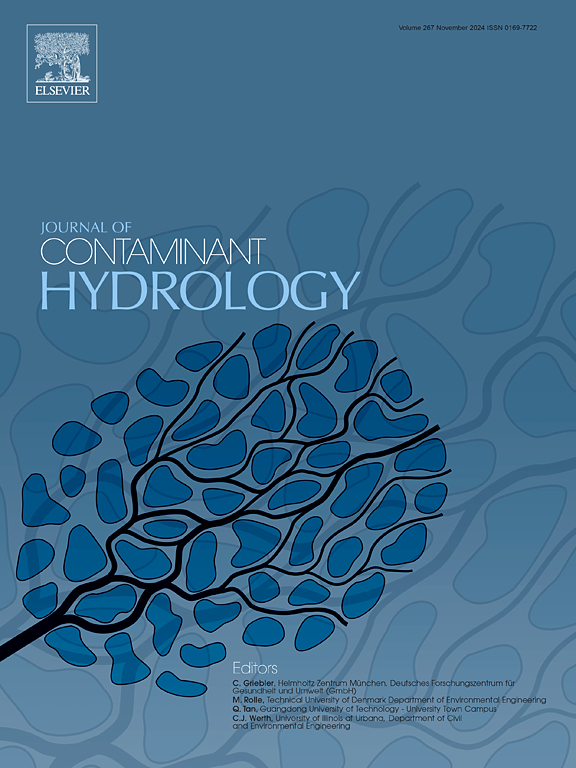Sensitivity analysis of a parameterization of coagulation in an aqueous transport model
IF 3.5
3区 环境科学与生态学
Q2 ENVIRONMENTAL SCIENCES
引用次数: 0
Abstract
A three-dimensional aqueous transport model, ALGE, was developed at the Savannah River National Laboratory (SRNL) as a tool for emergency response. Recently, coagulation and break-up of suspended sediment and particulate (contaminant adhered to sediment) matter has been added as a new model capability via bilinear interpolation of salinity and turbulence. A sensitivity analysis was performed by comparing time series of suspended sediment and particulate concentrations at various locations when the model's parameters (particle size and density) are altered. Concentrations produced by the model match well with the literature, producing concentrations between 0.05 and 0.25 kg/m3. Simulations of suspended sediment also show similar trends to the literature, where concentrations reach equilibrium faster in a salinity driven environment (>0.5 days) when compared to a freshwater environment (∼1 day). Sensitivity results show significant differences (P-values <0.05) between suspended sediment experiments in both freshwater and saltwater systems when all parameters (particle diameter, density, fraction of mass) vary, whereas significant differences (P-value <0.05) between particulate tracer experiments occur primarily at the source of the release.
水输运模型中混凝参数化的敏感性分析
萨凡纳河国家实验室(SRNL)开发了一种三维水输运模型ALGE,作为应急响应工具。最近,通过盐度和湍流的双线性插值,加入了悬浮沉积物和颗粒(附着在沉积物上的污染物)物质的混凝和破碎作为新的模型能力。当模型参数(粒度和密度)改变时,通过比较不同地点悬浮沉积物和颗粒浓度的时间序列进行敏感性分析。模型产生的浓度与文献吻合良好,产生的浓度在0.05至0.25 kg/m3之间。悬浮沉积物的模拟也显示出与文献相似的趋势,与淡水环境(~ 1天)相比,在盐度驱动的环境中(>;0.5天)浓度达到平衡更快。当所有参数(颗粒直径、密度、质量分数)都不同时,淡水系统和咸水系统悬浮沉积物实验的敏感性结果存在显著差异(p值<;0.05),而颗粒示踪剂实验之间的显著差异(p值<;0.05)主要发生在释放源处。
本文章由计算机程序翻译,如有差异,请以英文原文为准。
求助全文
约1分钟内获得全文
求助全文
来源期刊

Journal of contaminant hydrology
环境科学-地球科学综合
CiteScore
6.80
自引率
2.80%
发文量
129
审稿时长
68 days
期刊介绍:
The Journal of Contaminant Hydrology is an international journal publishing scientific articles pertaining to the contamination of subsurface water resources. Emphasis is placed on investigations of the physical, chemical, and biological processes influencing the behavior and fate of organic and inorganic contaminants in the unsaturated (vadose) and saturated (groundwater) zones, as well as at groundwater-surface water interfaces. The ecological impacts of contaminants transported both from and to aquifers are of interest. Articles on contamination of surface water only, without a link to groundwater, are out of the scope. Broad latitude is allowed in identifying contaminants of interest, and include legacy and emerging pollutants, nutrients, nanoparticles, pathogenic microorganisms (e.g., bacteria, viruses, protozoa), microplastics, and various constituents associated with energy production (e.g., methane, carbon dioxide, hydrogen sulfide).
The journal''s scope embraces a wide range of topics including: experimental investigations of contaminant sorption, diffusion, transformation, volatilization and transport in the surface and subsurface; characterization of soil and aquifer properties only as they influence contaminant behavior; development and testing of mathematical models of contaminant behaviour; innovative techniques for restoration of contaminated sites; development of new tools or techniques for monitoring the extent of soil and groundwater contamination; transformation of contaminants in the hyporheic zone; effects of contaminants traversing the hyporheic zone on surface water and groundwater ecosystems; subsurface carbon sequestration and/or turnover; and migration of fluids associated with energy production into groundwater.
 求助内容:
求助内容: 应助结果提醒方式:
应助结果提醒方式:


